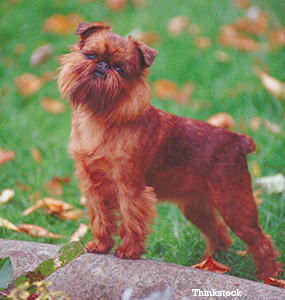Background:
Brussels Griffons are from Belgium and are descended from ratter dogs. They’re a cross between the Affenpinscher and the Belgian Street Dog. These bearded dogs were probably first brought to public attention by way of the paintbrush. Later they became popular farm dogs and finally everyday household dogs. They were a versatile breed: some used as watchdogs and others used by cab drivers to attract riders.
World War I and II took a sizeable toll on Brussels Griffon numbers. It was only through a concerted effort (primarily on the part of the British), that they survived. Popularity was slow to come in America where even today Brussels Griffons are relatively rare. Numbers did spike after being featured in the 1997 film “As Good as It Gets.”
Sizing up:
- Weight: 8 to 12 lbs.
- Height: not specified
- Coat: Smooth coat or rough coat.
- Color: Red, belge (black and reddish brown), black and tan, black
- Life expectancy: 12 to 15 years
What’s the Brussels Griffon like?
Apartment living is a fine life as far as Griffons are concerned. They’re primarily an indoor dog and don’t mind having playtime away from the elements. If it’s a nice day they would still love a good walk, but their overall exercise needs are relatively easy to keep up with. Griffons are smart and love to play games with their people. Griffons have a reputation as a “Velcro dog,” so you don’t want to leave them alone for too long. When it is necessary to leave Brussels Griffons home alone a crate might be required to keep them from tearing up the house or apartment.
Brussels Griffons are known to be bossy and if you let them they will certainly rule the house. These traits need to be adjusted early during training. You absolutely should establish yourself as the dominant presence. Don’t try and force the Griffon to do anything though, just reward him when he does something right.
Griffons will need to be the center of attention and don’t like kids stealing the spotlight. They’ll want to be your only child. Their small size also means children who play too rough could injure them. They do like other dogs but often don’t understand their own size and will try and dominate packs.
Griffons can climb and dig better than most dogs so you should be sure your fence is high and deep. If you need to expel any additional energy, dog sports and agility competitions are well suited to the Brussels Griffon.
Health:
Any of the following conditions are possible in Brussels Griffons:
- Luxating patella
- Progressive retinal atrophy
- Cataracts
- Syringomyelia
- Cleft palate
Takeaway points:
- Brussels Griffons should not be exposed to the elements for too long, they’re primarily indoor dogs.
- Brussels Griffons can jump fences or dig underneath them.
- Brussels Griffons often underestimate their own size so be careful around large dogs.
- Brussels Griffons can live in small apartments.
If you have any questions or concerns, you should always visit or call your veterinarian -- they are your best resource to ensure the health and well-being of your pets.
